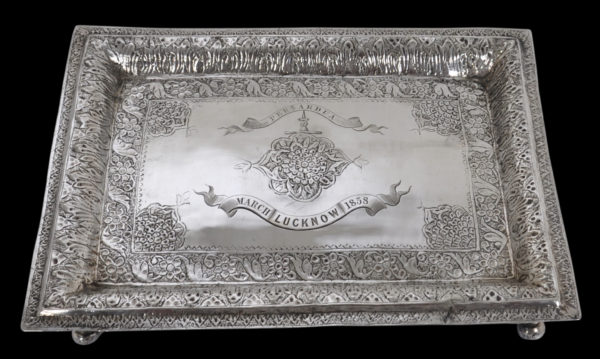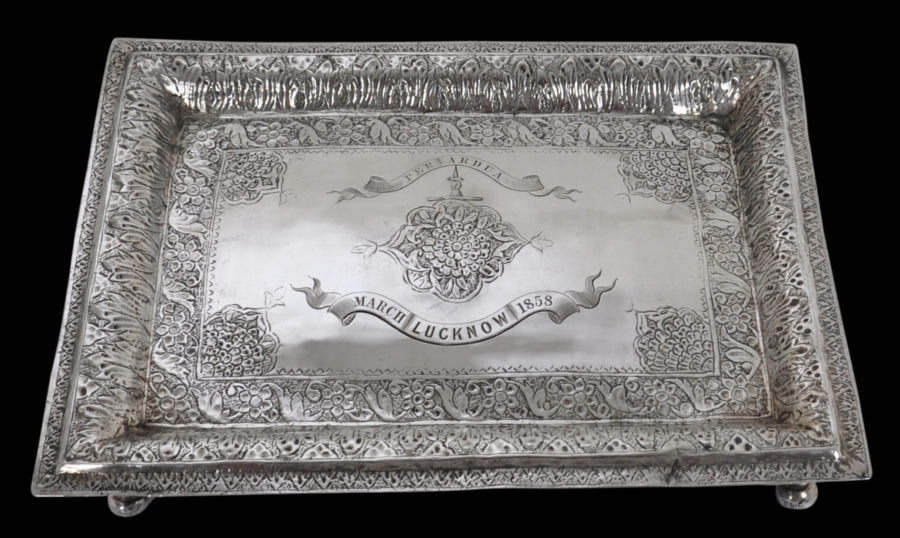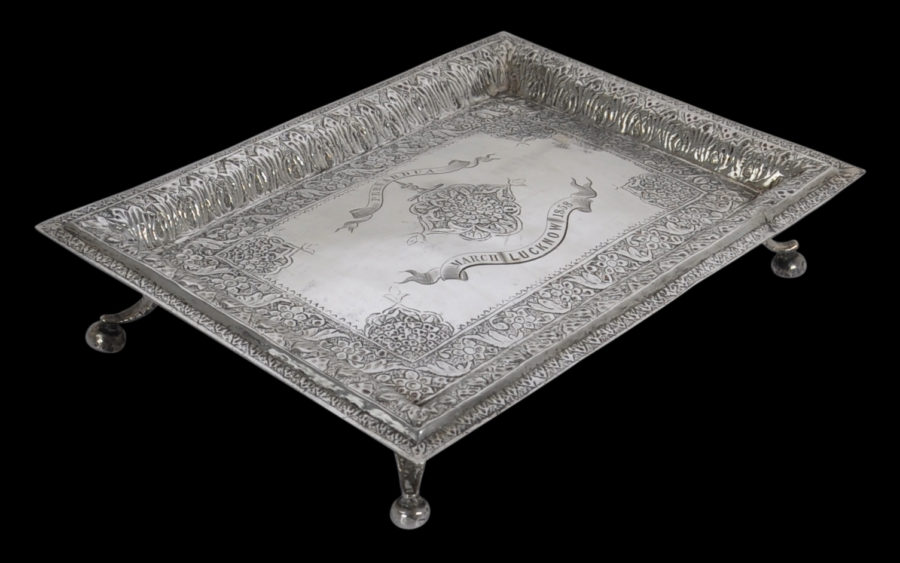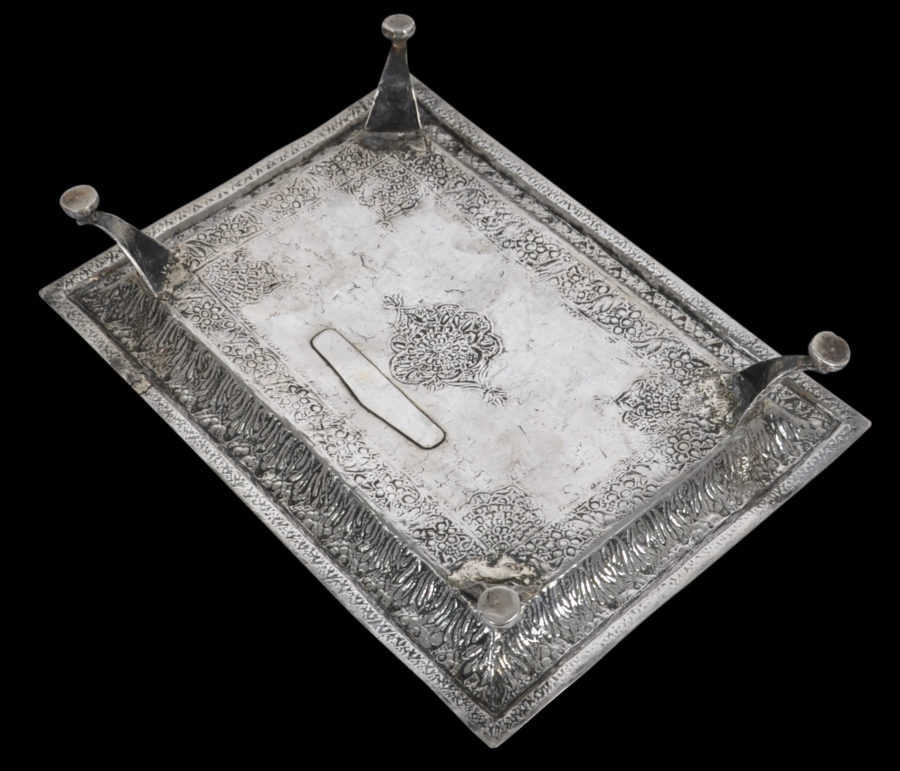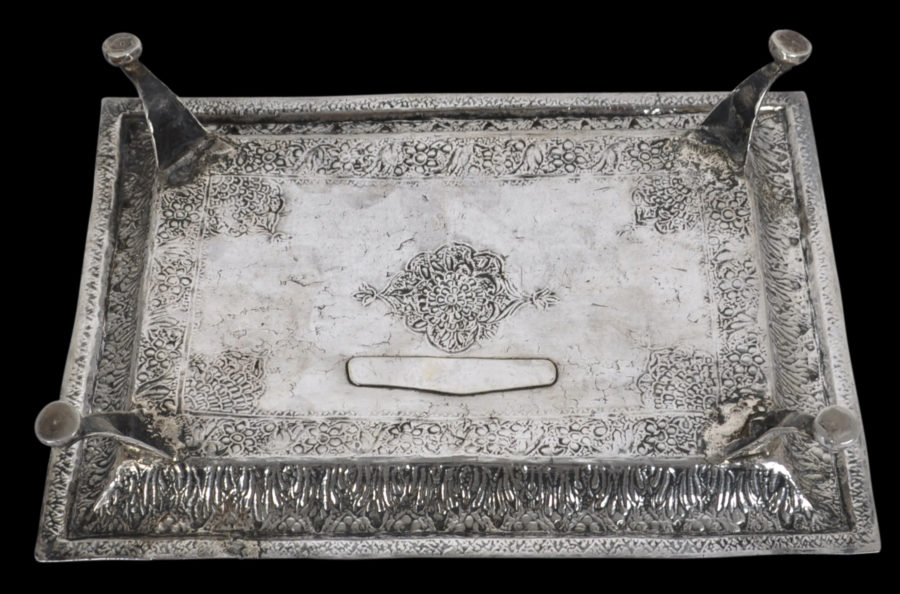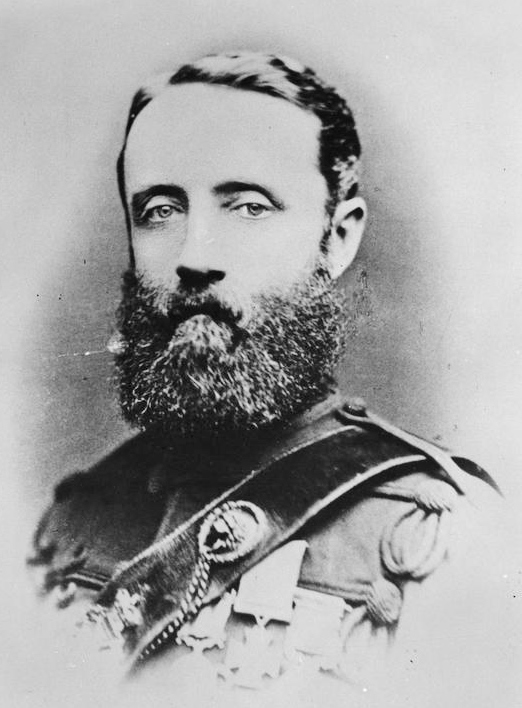Enquiry about object: 6150
Chased, Inscribed & Dated Silver Betel Tray, Captured at the Siege of Lucknow
Lucknow, India late 18th century with a later inscribed date of 1858
length: 28.6cm, width: 21.4cm, height: 5.5cm, weight: 540g
Provenance
taken at the siege of Lucknow; Major General Donald Macintyre VC
This important relic from the Siege of Lucknow comprises a rectangular high-grade, solid-silver pandan tray on which paan or betenut would have been served. It dates to the late 18th century.
The tray is chased and engraved, has a raised rim and stands on four legs.
The tray’s form and decoration is typical of aristocratic pieces from 18th century Lucknow. A scent tray of similar form is illustrated in Markel et al (2010, p. 212) and a rosewater casket with similar chasing is illustrated in the same volume (p. 210).
Originally, the tray was chased with floral and leafy borders around the interior base, over the interior sides, and the outer edge, leaving the central area unmarked.
The tray is engraved such that it has become a memento of the Siege of Lucknow, and it can be readily assumed that it was taken during the Siege.
The tray was engraved after the Siege with the motto ‘Per Ardua’ in a ribbon over a clenched fist holding a dagger. This is the arms for the MacIntyre family of Scotland, and so the tray almost certainly was taken at the Siege by Donald Macintyre, later Major General Donald Macintyre VC (1831- 1903). [See the last photograph below for his image.]
Macintyre was second son of Donald Macintyre of Calcutta by his wife Margaret, daughter of John Mackenzie of Kincraig House, Ross-shire. Educated at private schools in England and abroad, he was at the East India Company’s Military College, Addiscombe, from 1848 to 1850, and obtained his first commission in the Bengal army in June 1850. Later, he was awarded the Indian Mutiny Medal (1857-58). The Medal was a campaign medal approved in 1858, for issue to officers and men of British and Indian units who served in operations in suppression of the Indian Mutiny, which encompassed recapture of Delhi and the Siege of Lucknow.
The ruling family of Oudh (Lucknow) established themselves as independent hereditary rulers during the collapse of Mughal power in the early eighteenth century.
The strategic position of their capital and that of Oudh province prompted the British to use them as a buffer state between their own territories in the east, and the west. However the British used the inevitable intrigue and jockeying in the Oudh court to exert greater and greater influence. By the turn of the nineteenth century they managed to virtually exercise a veto right on the succession. The Nawabs devoted much of their time trying to project the outward signs of their sovereignty and regality, rather than exerting real power. Accordingly, Lucknow became an important centre for court arts.
Wajid ‘Ali Shah was the last Nawab of Oudh. By the mid-nineteenth century, the Nawabs had lost their political and military usefulness to the British, and so the British under Dalhousie, Governor General of the East India Company, annexed the kingdom outright in 1856 on the grounds of internal misrule. It was in Oudh where the first great revolt of Indian Independence started in 1857.
The actual siege of Lucknow occurred between 30 May and 27 November 1857. But the British finally retook Lucknow, starting from 6 March 1858 with all fighting over by 21 March 1858.
Meanwhile Wajid ‘Ali Shah was exiled to Calcutta with most of his family. The Siege of Lucknow had its origins in the annexation and the Nawab’s exile. The high-handed action by the East India Company was resented within the state and elsewhere in India.
The tray has obvious age and wear. Several old splits to the rim and base have been repaired over time. The purity of the silver used is such that it is likely to be more pure than sterling silver. It is in a fine, stable condition, and is a superb, historical relic.
References
Bhatt, R., The Life and Times of the Nawabs of Lucknow, Rupa & Co, 2006.
Llewellyn-Jones, R. (ed.), Lucknow: City of Illusion (The Alkazi Collection of Photography), Prestel, 2006.
Markel, S. et al, India’s Fabled City: The Art of Courtly Lucknow, LACMA/DelMonico Books, 2010.
Trivedi, S.D., Masterpieces in the State Museum, Lucknow, 1989.
Varshney, V.P., Lucknow: The City of Heritage & Culture, Niyogi Books, 2017.


